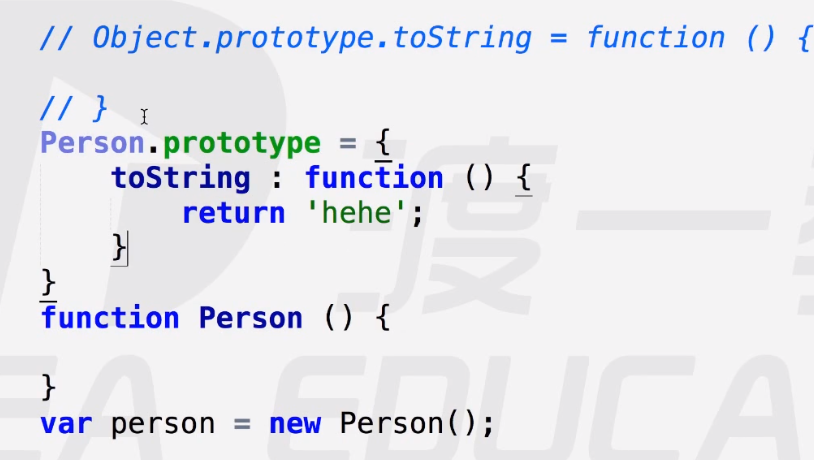全局对象 window
ECMAScript 规定全局对象叫做 global,但是浏览器把 window 作为全局对象(浏览器先存在的)
window 就是一个哈希表,有很多属性。window 的属性就是全局变量。
这些全局变量分为两种:
- 一种是 ECMAScript 规定的
- global.parseInt
- global.parseFloat
- global.Number
- global.String
- global.Boolean
- global.Object
- 一种是浏览器自己加的属性
- window.alert
- window.prompt
- window.comfirm
- window.console.log
- window.console.dir
- window.document
- window.document.createElement
- window.document.getElementById
共有属性-原型-原型链
原型是 function 对象的一个属性,它定义了构造函数制造出的对象的公共祖先。通过该构造函数产生的对象,可以继承该原型的属性和方法。原型也是对象
- prototype一上来就有
- 把对象共有的属性放在原型里
- 子对象不能改变和删除构造函数的原型属性
//Person.prototype = {} 祖先Person.prototype.lastName = 'mengfeisi'Person.prototype.say = function() {console.log('hahaha')}function Person(firstName, age, sex) {this.firstName = firstNamethis.age = agethis.sex = sex}var person = new Person()var person1 = new Person()var person2 = new Person('小明', 25, '男')console.log(person.lastName) //mengfeisiconsole.log(person1.lastName) //mengfeisiperson1.lastName = 'deng'console.log(person1.lastName) //dengconsole.log(person2.firstName) //小明console.log(person2.lastName) //mengfeisiconsole.log(person.say())console.log(person1.say())---------------------------------------function Person() {}Person.prototype.name = ''function Car() {}Car.prototype.name = 'BMW'var car = new Car()console.log(car.constructor) //Car() {}Car.prototype.constructor = Personconsole.log(car.constructor) //Person() {}console.log(car.name) //BMW
proto
function Person() {}Person.prototype.name = 'hahaha'var person = new Person()console.log(person.__proto__) //{name: 'hahaha', constructor: ƒ}console.log(person.name) //hahahavar obj = {name: 'sunny',}person.__proto__ = objconsole.log(person.__proto__) //{name: 'sunny'}console.log(person.name) //sunny

{var num = [1, 2, 3, 4]var num1 = numnum = num.push(5)console.log(num1) //[1, 2, 3, 4, 5]}{var num = [1, 2, 3, 4]var num1 = numnum = [1, 1, 1, 1, 1]console.log(num1) //[1, 2, 3, 4] 更换了地址空间}{function Person() {//var this = {__proto__:Person.prototype}}Person.prototype.name = 'sunny'var person = new Person() //var this = {__proto__:Person.prototype}Person.prototype = {name: 'cherry',}console.log(person.name)//sunny 更换了地址空间}
角色:Object的共有属性区,包装类的共有属性区,对象,
- 对象的的“proto”指向包装类的共有属性区,包装类的prototype也指向包装类的共有属性区
- 包装类的共有属性区中的“proto”指向Object的共有属性区,Object的prototype也指向Object的共有属性区
- Object的共有属性区中的“proto”指向null
- 对象.proto === 函数.prototype
Function
函数.proto === Function.prototype
Function.proto === Function.prototype
原型的作用
function Animal(name) {this.name = name;}Animal.prototype.color = 'white';var cat1 = new Animal('大毛');var cat2 = new Animal('二毛');cat1.color // 'white'cat2.color // 'white'
原型对象上添加一个color属性,结果,实例对象都共享了该属性
原型对象的属性不是实例对象自身的属性。只要修改原型对象,变动就立刻会体现在所有实例对象上
Animal.prototype.color = 'yellow';cat1.color // "yellow"cat2.color // "yellow"
实例对象本身没有某个属性或方法的时候,它会到原型对象去寻找该属性或方法。这就是原型对象的特殊之处
如果实例对象自身就有某个属性或方法,它就不会再去原型对象寻找这个属性或方法
cat1.color = 'black';cat1.color // 'black'cat2.color // 'yellow'Animal.prototype.color // 'yellow'
总结一下,原型对象的作用,就是定义所有实例对象共享的属性和方法。这也是它被称为原型对象的原因,而实例对象可以视作从原型对象衍生出来的子对象
var object = {}object.__proto__ === Object.prototypevar fn = function(){}fn.__proto__ === Function.prototypefn.__proto__.__proto__ === Object.prototypevar array=[]array.__proto__ === Array.prototypearray.__proto__.__proto__ === Object.prototypeFunction.__proto__ === Function.prototypeArray.__proto__ === Function.prototypeObject.__proto__ === Function.prototypetrue.__proto__ === Boolean.prototypeFunction.prototype.__proto__ === Object.prototype
对象的原型


原型链

function Father() {this.name = 'xuming'this.fortune = {card1: 'visa',}this.num = 100}var father = new Father()Son.prototype = fatherfunction Son() {this.hobbit = 'smoke'}var son = new Son()//不能修改父亲的属性console.log(son.name) //xumingson.name = 'laotouzi'console.log(son.name) //laotouziconsole.log(father.name) //xuming//可以修改父亲中的对象的属性console.log(son.fortune) //{card1: 'visa'}son.fortune.card2 = 'zhongguo'son.fortune.card1 = 'visa-son'console.log(son.fortune) //{card1: 'visa-son', card2: 'zhongguo'}console.log(father.fortune) //{card1: 'visa-son', card2: 'zhongguo'}console.log(son.num) //100son.num++console.log(son.num) //101 son.num++ ---> son.num = son.num + 1console.log(father.num) //100console.log(son)


Object.create(原型)


方法重写
如果一层层地上溯,所有对象的原型最终都可以上溯到Object.prototype,也就是说,所有对象都继承了Object.prototype的属性。这就是所有对象都有valueOf和toString方法的原因,因为这是从Object.prototype继承的
Object.prototype的原型是null。null没有任何属性和方法,也没有自己的原型。因此,原型链的尽头就是nullObject.getPrototypeOf(Object.prototype) // null
读取对象的某个属性时,JavaScript 引擎先寻找对象本身的属性,如果找不到,就到它的原型去找,如果还是找不到,就到原型的原型去找。如果直到最顶层的Object.prototype还是找不到,则返回undefined。如果对象自身和它的原型,都定义了一个同名属性,那么优先读取对象自身的属性,这叫做“覆盖”(overriding)
注意,一级级向上,在整个原型链上寻找某个属性,对性能是有影响的。所寻找的属性在越上层的原型对象,对性能的影响越大。如果寻找某个不存在的属性,将会遍历整个原型链




javascript初始化



